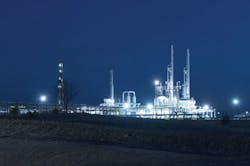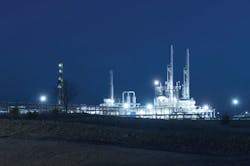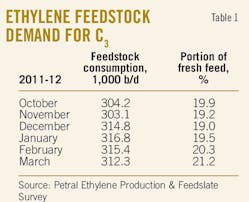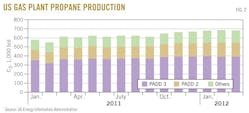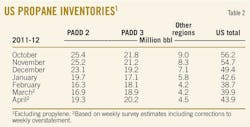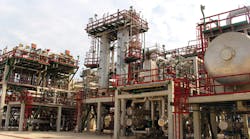Dan Lippe
Petral Worldwide Inc.
Houston
Weather events such as hurricanes or cold winters always concern the propane marketing community, but the event that everyone dreads is a mild winter.
The winter of 2011-12 was persistently warmer than average November through March. The mild weather was so pervasive that the year-to-year declines in propane demand in all regional retail markets were of historic proportions.
The decline in demand from winter 2010-11 created an inventory surplus of 15-20 million bbl. The inventory surplus in the US and Canada will be a sustained bearish influence on propane markets and pricing in North America during third and fourth quarters 2012.
Feedstock demand
In fourth-quarter 2011, feedstock demand for propane was 307,400 b/d, 6,700 b/d higher than in third-quarter 2011. Demand in fourth-quarter 2011 was also 14,800 b/d (5.1% and 1.4 million bbl) higher than demand in fourth-quarter 2010.
Historically, feedstock demand for propane is an important and predictable balancing element for the overall propane supply-demand balance in North America. When colder weather pushes sales and consumption in retail markets steadily higher, ethylene producers in the Gulf Coast generally reduce consumption and effectively offset some of the impact of the increases in retail demand. These countertrends normally help keep the overall market in balance. Similarly, as consumption in retail markets falls sharply during March through June, feedstock demand generally recovers beginning in March or April. The inventory surplus at the end of March is sufficient to support 100,000-120,000 b/d of additional feedstock demand during second-half 2012. |
The increase in feedstock demand during fourth-quarter 2011 was atypical for the seasonal pattern of weaker demand in fourth quarters vs. third quarters but consistent with economic incentives for ethylene producers resulting from the weak increases in retail demand during November and December.
Demand averaged about 315,000 b/d in first-quarter 2012 and was 7,500 b/d higher than in fourth-quarter 2011. Feedstock demand for first-quarter 2012 was also about 20,000 b/d (6.7% and 1.8 million bbl) higher than in first-quarter 2011.
Propane's share of fresh feed averaged 19.4% during fourth-quarter 2011 and 20.3% during first-quarter 2012. Propane's share of fresh feed for fourth and first quarters was 18.0-19.0% during 2006-10 and the maximum was 21.3%. As economic incentives for feedstock demand increased during first-quarter 2012, propane's share of fresh feed increased to 21.2% in March and was almost equal to the 5-year maximum of 21.3%.
Table 1 summarizes trends in ethylene feedstock demand for propane.
Profit margins for most plants during fourth-quarter 2011 were generally 40-60% less than in third-quarter 2011. Ethylene production averaged 145.1 million lb/day in fourth-quarter 2011 and was 3.5 million lb/day (2.3%) less than in third-quarter 2011. The decline in production in fourth-quarter 2011 resulted from turnarounds in October 2011 at two large crackers on the Gulf Coast.
In addition, three other crackers there experienced unplanned downtime at various times during fourth-quarter 2011. After ethylene producers completed turnarounds and resolved unplanned downtime in October, production recovered and averaged 148 million lb/day for November and December, or only 0.5 million lb/day less than in third-quarter 2011.
At the beginning of 2012, the ethylene industry faced a heavy schedule of plant turnarounds for February through June 2012, and most were generally scheduled to last 4-6 weeks. According to Petral's monthly survey results, ethylene production averaged 148 million lb/day in January but dropped to 142 million lb/day in February and 135 million lb/day in March 2012.
Ethylene production in first-quarter 2012 averaged 142 million lb/day, 3.4 million lb/day (2.4%) less than in fourth-quarter 2011. Plant turnarounds continued to limit ethylene production rates during second-quarter 2012. We expect ethylene producers to increase production to 150 million lb/day during third and fourth quarters 2012 as necessary to rebuild ethylene inventory to acceptable levels.
We estimate total demand for fresh feed averaged 1.53-1.55 million b/d during second-quarter 2012, and we forecast total demand for fresh feed will increase to 1.60-1.62 million b/d during third and fourth quarters 2012.
Since propane demand in retail markets during the winter heating season was 20 million bbl less than expected, propane availability will be plentiful during summer and fall 2012.
Based on forecasts for ethylene production and total feed and average share of fresh feed, we forecast feedstock demand for propane will average 315,000-335,000 b/d during third and fourth quarters 2012. At the midrange of the forecast, the year-to-year increase in demand would be equal to about 4 million bbl.
Based on historic maximum share of fresh feed during 2006-10, feedstock demand for propane could be as high as 350,000 b/d, or almost 9 million bbl more than during third and fourth quarters 2011.
Propane's use as a space-heating fuel in residential and commercial markets usually begins to increase from its off-season slump each year in September and reaches its peak during December-February. During winter 2011-12, retail demand tracked the usual seasonal pattern. Demand in residential and commercial markets throughout North America was less than during winter 2011-12, however, due to persistently warmer than average temperatures during November through March. Heating-degree days during December and January were particularly low relative to the previous year. |
Fig. 1 shows historic trends in ethylene feedstock demand for propane.
Retail demand
Temperatures were cooler than average at the beginning of winter 2011-12. Statistics published by US National Weather Service Climate Prediction Center showed heating-degree days for the upper Midwest and Northeast were 15-35% warmer than the previous year in September 2011 and were 8-12% warmer than in October 2011.
Unfortunately for wholesalers and retailers, propane sales to residential-commercial customers do not reach peak levels until December-January. After October, winter weather was persistently warmer than average. During the critical months of December 2011 and January 2012, heating-degree days were 25-33% and 20-22% fewer than the previous year, for customers in the upper Midwest and Northeast, respectively.
We estimate retail demand for fourth-quarter 2011 averaged 730,000 b/d and was 55,000 b/d (5.1 million bbl) less than in fourth-quarter 2010. The average for 2007-09 was 816,800 b/d. We estimate demand for first-quarter 2012 averaged 876,100 b/d and was 182,100 b/d (16.6 million bbl) less than in first-quarter 2011.
Propane wholesalers and retailers generally view March as the last month of the winter heating season and April as the first month of the off-season. We forecast retail demand will average 315,000-325,000 b/d in second-quarter 2012 and 170,000-180,000 b/d in third-quarter 2012.
Exports
Spot prices in international markets were weak during fourth-quarter 2011. In the Middle East in October 2011, prices for spot cargoes were discounted 8¢/gal vs. spot prices in Mont Belvieu, Tex. Spot prices in the Middle East increased 5¢/gal in November, but prices remained 1¢/gal below spot prices in Mont Belvieu.
Prices in the Middle East increased another 7¢/gal in December 2011, and the premium vs. Mont Belvieu was 12¢/gal. Prices in international markets surged during first-quarter 2012, and premiums were 50-90¢/gal for spot cargoes in the Middle East vs. spot prices in Mont Belvieu.
Propane exports fell sharply in October 2011 due to the temporary reversal of Mont Belvieu price advantages vs. key international supply sources. The return to limited price advantages, however, sparked a recovery, and US exports were 120,000-125,000 b/d during November and December 2011 vs. 58,700 b/d in October 2011.
As price incentives for exports surged, US exports increased during first-quarter 2012. Exports were 148,300 b/d in January and 125,000-130,000 b/d in February and March. For the winter heating season 2011-12, propane exports were 21.6 million bbl but were 1.66 million bbl less than year-earlier volumes due to the slump in waterborne exports during October 2011.
During 2006-08, propane imports from Canada typically averaged 130,000-180,000 b/d during fourth and first quarters. Imports from Canada during fourth and first quarters 2009 and 2010 declined to 120,000-130,000 b/d. In addition, East Coast terminals routinely receive shipments from international sources at peak seasonal rates during fourth and first quarters. Waterborne imports through East Coast terminals during fourth and first quarters were typically 25,000-55,000 b/d during 2007-10. |
Propane supply
Based on data published by the US Energy Information Administration, total domestic production from gas plants and net propane production from refineries averaged 940,700 b/d for fourth-quarter 2011. Production in fourth-quarter 2011 was 89,500 b/d (8.2 million bbl) higher than year-earlier volume.
From EIA data for January and February 2012, we estimate total domestic production was 955,000-965,000 b/d in first-quarter 2012. Production in first-quarter 2012 was 104,100 b/d (9.6 million bbl) higher than year-earlier volumes.
Gas plants
EIA statistics indicate that gas plant propane production averaged 658,500 b/d for fourth-quarter 2011. Production was 38,400 b/d (3.5 million bbl) higher than in third-quarter 2011. EIA statistics show gas plant production in January and February 2012 averaged 688,300 b/d.
We estimate production averaged 685,000 for first-quarter 2012. Finally, we forecast gas plant production will average 680,000-690,000 b/d during second, third, and fourth quarters 2012.
Fig. 2 shows trends in propane production from gas plants.
Refineries
For fourth-quarter 2011, EIA statistics showed propane production from refineries (net of propylene for propylene chemicals markets) averaged 282,200 b/d and was 16,600 b/d higher than in third-quarter 2011.
For first-quarter 2012 (based on EIA statistics for January and February and Petral estimates for March), refinery propane production was 270,000-275,000 b/d. We forecast purity propane supply from refineries will average 270,000-280,000 b/d for second, third, and fourth quarters 2012.
Fig. 3 shows trends in total propane production (gas plants and refineries).
Imports
Data published by the US Census Bureau's Foreign Trade Division for fourth-quarter 2011 show total imports averaged 138,100 b/d, and imports from Canada 118,600 b/d. Total imports were 19,300 b/d fewer than year-earlier volumes.
Imports from Canada during fourth-quarter 2011 were 3,500 b/d lower than year-earlier volumes. East Coast import terminals received 19,500 b/d of waterborne imports during fourth-quarter 2011, or 15,800 b/d fewer than year-earlier volumes.
In first-quarter 2012, based on Foreign Trade Division statistics for January and February and estimates for March, total imports averaged 140,000-145,000 b/d and were 15,000-20,000 b/d fewer than during first-quarter 2011.
Imports from Canada averaged about 100,000-110,000 b/d, and waterborne imports through East Coast import terminals were 30,000-40,000 b/d. Imports from Canada were about 20,000-25,000 b/d fewer in first-quarter 2012 than in 2011, but waterborne imports into East Coast terminals were 5,000-6,000 b/d more than in 2011.
We forecast total imports into the US will average 70,000-90,000 b/d in second and third quarters 2012. The inventory surplus of 15-20 million bbl indicates total imports may be much lower than typical off-season volumes. Imports from Canada will probably equal historic average volumes, however, as Canadian marketers steadily liquidate surplus inventory in Canadian storage before the beginning of next winter's heating season.
Operators of East Coast waterborne import terminals are likely to take typical volumes during second, third, and fourth quarters 2012.
Inventory trends
Propane inventory (excluding nonfuel propylene inventory included in EIA gross propane and propylene inventory data) in primary storage in the US was 56.1 million bbl on Nov. 1, 2011.
EIA statistics from the Petroleum Supply Monthly (PSM) showed inventory on Nov. 1 was 3.7 million bbl less than year-earlier volumes and 1.4 million bbl less than the 3-year average. At the beginning of winter 2011-12, producers and wholesale marketers were concerned average inventory liquidation rates would pull inventory levels on Apr. 1 to new record lows particularly on the Gulf Coast. In view of colder than average temperatures during September and October, concerns about supply were reasonable.
Inventory withdrawals November through February, however, were a meager 16.1 million bbl. In comparison, withdrawals were 45.5 million bbl during winter 2009-10 and 36.9 million bbl during winter 2010-11. EIA weekly reports show US inventory on Apr. 1 was at about 40 million bbl and was 17.4 million bbl more than year-earlier volumes and 16 million bbl more than the 3-year average.
As winter 2011-12 progressed with persistently mild weather and weak retail demand, perceptions among propane producers and wholesale marketers shifted radically. Producers and marketers became increasingly concerned about high inventory volumes remaining in storage on Apr. 1. Concerns among producers and marketers became a full blown "sellers panic" during late April and early May.
Inventory in Canada typically begins to decline in October and reaches its seasonal minimum on Mar. 1. Seasonal withdrawals are usually 8.5-9.5 million bbl. In 2011, inventory in underground Canadian storage was 12.1 million bbl on Oct. 1, according to Canada's National Energy Board statistics. Based on typical seasonal withdrawals, Canadian propane marketers had reasonable expectations that inventory would fall to a low of 2.7-3.7 million bbl.
Seasonal withdrawals were only 5.9 million bbl, however, and inventory was 6.3 million bbl on Mar. 1, or 2.5 million bbl more than the 5-year average and 2.0 million bbl more than year-earlier volumes. Weak demand in the US northern tier limited Canadian exports throughout the winter and limited overall withdrawals from storage.
Canada's NEB also reports the breakout of purity-propane inventory vs. propane contained in unfractionated mix. Its statistics showed purity inventory in Canada totaled 9.3 million bbl on Oct. 1 and fell to a seasonal low of 4.4 million bbl. At this volume, purity inventory was 0.7 million bbl lower than in 2010 and 0.9 million bbl lower than the 5-year average. On Apr. 1, spec propane inventory increased to 5.0 million bbl, or 3.2 million bbl more than in 2011.
For North America, inventory (excluding nonfuel propylene) totaled 67.9 million bbl on Nov. 1, 2011, and were 4.1 million bbl fewer than in 2010. By Jan. 1, 2012, mild weather and weak retail demand had begun to take its toll. Inventories in US and Canadian storage were 59.0 million bbl, or 3.6 million bbl more than a year earlier. As the winter progressed and temperatures remained warmer than normal, the year-to-year inventory surplus increased to about 25 million bbl on Apr. 1.
Markets in North America have the twin levers of increasing ethylene feedstock demand or exports or both to avoid inventory accumulation pushing storage in the Midcontinent to 100% utilization by mid to late summer.
Fig. 4 shows trends in propane inventory in US storage.
Regional inventory trends
EIA statistics for Nov. 1, 2011, showed 25.4 million bbl of propane inventory in primary storage in US Petroleum for Defense District (PADD) 2 (see box at top of p. 74 for PADD regions). Inventory on Nov. 1 was 1.1 million bbl less than a year earlier and 0.6 million bbl less than the 3-year average. Inventory withdrawals were an anemic 9.1 million bbl during November through February.
EIA monthly reports in PSM showed inventory in primary storage in PADD 2 fell to a low of 16.3 million bbl on Mar. 1, 2012. At this volume, inventory was 6.8 million bbl more than in 2011 and accounted for about 50% of the year-to-year increase in total US inventory. Furthermore, the inventory surplus on Mar. 1 was equivalent to about 40% of the typical increase in inventory in PADD 2 during second and third quarters.
PADD: US Petroleum Administration for Defense Districts*PAD District 1 (East Coast) consists of three subdistricts: • Subdistrict 1A (New England): Connecticut, Maine, Massachusetts, New Hampshire, Rhode Island, Vermont. • Subdistrict 1B (central Atlantic): Delaware, District of Columbia, Maryland, New Jersey, New York, Pennsylvania. • Subdistrict 1C (lower Atlantic): Florida, Georgia, North Carolina, South Carolina, Virginia, West Virginia. PAD District 2 (Midwest): Illinois, Indiana, Iowa, Kansas, Kentucky, Michigan, Minnesota, Missouri, Nebraska, North Dakota, South Dakota, Ohio, Oklahoma, Tennessee, Wisconsin. PAD District 3 (Gulf Coast): Alabama, Arkansas, Louisiana, Mississippi, New Mexico, Texas. PAD District 4 (Rocky Mountain): Colorado, Idaho, Montana, Utah, Wyoming. PAD District 5 (West Coast): Alaska, Arizona, California, Hawaii, Nevada, Oregon, Washington.. *PADDs were delineated during World War II to facilitate oil allocation. Source: US Energy Information Administration, Washington, DC |
EIA statistics showed inventory in primary storage in PADD 3 (excluding nonfuel propylene) was 21.8 million bbl on Nov. 1, 2011 and was 4.2 million bbl less than in 2010 and 7.2 million bbl below the 3-year average. EIA's monthly statistics showed inventory withdrawals from PADD 3 storage totaled only 4.7 million bbl during November through February. Withdrawals during the 2011-12 winter heating season were 10.9 million bbl less than the 3-year average.
Manuscripts welcomeOil & Gas Journal welcomes for publication consideration manuscripts about exploration and development, drilling, production, pipelines, LNG, and processing (refining, petrochemicals, and gas processing). These may be highly technical in nature and appeal, or they may be more analytical by way of examining oil and natural gas supply, demand, and markets. OGJ accepts exclusive articles as well as manuscripts adapted from oral and poster presentations. An Author Guide is available at www.ogj.com, click "home" then "Submit an article." Or contact the Chief Technology Editor ([email protected]; 713/963-6230; or fax 713/963-6282), Oil & Gas Journal, 1455 West Loop South, Suite 400, Houston, TX 77027, USA. |
On Mar. 1, 2012, inventory in PADD 3 storage was 18.1 million bbl. Inventory on Mar. 1 was 6.7 million bbl more than a year earlier but only 2.9 million bbl more than the 3-year average. The inventory surplus on Mar. 1 vs. 2011 was equal to about 50% of the typical seasonal build during second and third quarters.
Pricing, economics
Spot prices for dated Brent crude oil averaged $109/bbl during fourth-quarter 2011 and increased to $118/bbl during first-quarter 2012. Spot prices for dated Brent increased about $15/bbl during first-quarter 2012 and averaged $125/bbl in March.
Prices began to weaken in April and the slide accelerated during May. We view the slide in prices during April-May to be an overdue correction after 3 months of uninterrupted increases.
Propane prices in Mont Belvieu averaged 144.2¢/gal during fourth-quarter 2011, or 5¢/gal lower than in third-quarter 2011. Prices were 55.3% of dated Brent during fourth-quarter 2011 vs. 56.8% during third-quarter 2011. Prices declined during first-quarter 2012; they varied within a range of 120-130¢/gal and averaged 126.1¢/gal. Prices were only 44.8% of dated Brent during first-quarter 2012. During first-quarter 2012, price ratios fell from 49.2% in January to 42.3% in March.
Prices dropped to 119.6¢/gal in April and fell to less than $100¢/gal by May 7. The collapse in spot prices in Mont Belvieu during late April and early May confirmed the preliminary conclusion that inventory surpluses in PADDs 2 and 3 sparked a "sellers' panic."
Sometimes analysis of trends in feedstock parity values provides a different indication of relative strength or weakness from the perspective of ethylene feedstock buyers. For fourth-quarter 2011, ethylene producers had an incentive of 20-24¢/gal to use more propane and less natural gasoline and light naphtha feeds. Since propane's incentive vs. natural gasoline averaged about 9¢/gal during third quarter, prices were weaker during fourth-quarter 2011.
In contrast, propane prices were 12-18¢/gal too high to substitute for ethane during fourth-quarter 2011. Propane's disadvantage vs. ethane averaged 9¢/gal during third-quarter 2011. By this measure, propane prices were stronger relative to ethane (propane's most important competitor) during fourth-quarter 2011.
Propane's feedstock parity values shifted significantly during first-quarter 2012, and these changes clearly indicated that propane prices weakened. Propane remained at a disadvantage vs. ethane of 9¢/gal, but its advantage vs. natural gasoline surged to 35-45¢/gal.
As the decline in propane prices accelerated, propane and ethane were in parity, based on ethylene production costs during April 2012, and propane achieved a slight advantage in May 2012. Price incentives for propane vs. natural gasoline were 45¢/gal in April and widened to 50-55¢/gal in May.
The trends in price value relationships in the ethylene feedstock market during March through May clearly show spot prices in Mont Belvieu were very weak following the end of winter 2011-12.
Propane prices: summer, fall 2012
Financial traders accounted for 68-73% of total open interest in the NYMEX crude oil futures contract during fourth-quarter 2011 and first-quarter 2012, according to statistics published by the US Commodities Futures Trading Commission (CFTC).
CFTC statistics show that large traders in the managed money category boosted net-long positions (holding of long contracts minus short contracts) to a peak of 228,000 contracts in late February from 126,000 contracts in early October. The 81% increase in net long positions by managed money accounts coincided with a $28/bbl increase in WTI spot prices and a $20.68/bbl increase in dated Brent.
Civil war in Syria and Yemen disrupted crude oil production during fourth-quarter 2011 and into first-quarter 2012. Political tensions between Iran and the US and major European countries resulted in the European embargo of crude oil imports from Iran. The embargo was officially scheduled to begin in June, but Iran announced its decision to discontinue immediately crude oil sales to European countries. The early loss of Iranian crude oil supplies into Europe also contributed to a tightening supply-demand balance and bullish pressure on crude oil prices.
As expected, the price increases of 20-30% during fourth-quarter 2011 and first-quarter 2012 had bearish consequences for economic growth in Europe, North America, and China, and slower growth in global crude oil demand. Furthermore, voters in Greece, Spain, and France increased backlash pressures on the EU economic austerity programs. As Europe moves toward ending its economic union and common currency, major economies in Europe face increasing risks of sliding into recession.
These developments caused major traders to become increasingly concerned about falling demand and significantly less concerned about supply risks. Will Saudi Arabia cut production to prevent prices from falling "too low" during third-quarter 2012? The answer to this question is probably the most important influence on crude oil prices during third and fourth quarters 2012.
We highlight these trends to illustrate again how quickly concern among this group of traders can shift. Furthermore, despite the increasingly bearish outlook for global crude oil demand growth, big traders in the managed-account category maintained substantial net-long positions during the April-May price correction, according to weekly CFTC statistics.
Finally, just as Saudi Arabia gradually increased crude oil production to offset supply losses from Syria, Yemen, and Iran during first-quarter 2012, larger traders and crude oil buyers have to ask by how much and when Saudi Arabia will reduce production to offset weakening demand and slow the decline in prices during May. We forecast dated Brent prices to average $110-120/bbl during third and fourth quarters 2012.
Historically, consumption and sales for restocking secondary and tertiary storage (storage tanks controlled by retailers and consumers) are at their lowest levels of the year during May through July. It is no coincidence that producers and wholesalers aggressively accumulate inventory for the next winter's heating season during these 4 months.
This year, however, propane wholesalers and large retailers have no reason aggressively to accumulate supply for the coming winter. Instead, they have to cope with the aftermath of weak sales volumes and less cash in the bank. Producers also have less need to accumulate inventory and, inevitably, will turn to ethylene feedstock buyers and international LPG trading companies to sell increased volumes.
Large NGL traders will patiently wait on the sidelines until prices begin to rebound. The rebound in spot prices in Mont Belvieu may not occur until August-September or even as late as October.
We know bearish supply-demand considerations and bearish market sentiment dominated price trends during May. We expect bearish considerations will continue to dominate prices trends in Mont Belvieu until September or October, and we forecast prices in Mont Belvieu will average 90-100¢/gal.
As the onset of winter approaches and retailers belatedly begin to finalize supply commitments during September-October, bearish sentiment will dissipate. Supply-demand considerations will swing from bearish to neutral. Additionally, feedstock parity values will support a price rebound. We forecast prices in Mont Belvieu will increase to 120-130¢/gal during fourth-quarter 2012.
CORRECTIONWrong data inadvertently were published in the January 2011 column of the Nelson-Farrar monthly cost indexes table (OGJ, May 7, 2012, p. 101). Here are the corrected entries: pumps, compressors, etc. 2,073.3; electrical machinery 513.7; internal-comb. engines 1,036.3; instruments 1,469.0; heat exchangers 1,103.5; misc. equip. avg. 1,238.6; materials component 1,549.5; labor component 2,960.5; refinery (inflation) index 2,396.1; fuel cost 1,186.7; labor cost 282.3; wages 1,298.5; productivity 459.9; invest., maint., etc. 871.3; chemical costs 487.8; refinery 641.1; and process units 805.0. |
The author
More Oil & Gas Journal Current Issue Articles
More Oil & Gas Journal Archives Issue Articles
View Oil and Gas Articles on PennEnergy.com
